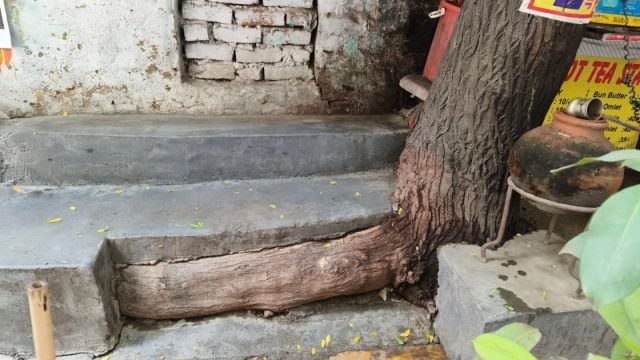‘Ped gir gaya toh bas sab khatam’: How Delhi’s trees are turning into daily hazards
Last month, a 50-year-old man was crushed to death when a tree fell on his bike. The Indian Express visited several areas across Delhi to see how the city’s trees are faring.
 In Begumpur, concretisation has trapped a tree, forcing it to spread sideways and upward. (Express photo)
In Begumpur, concretisation has trapped a tree, forcing it to spread sideways and upward. (Express photo)Written by Aanavi V Anand & Kaina Gupta
On August 14, a 50-year-old man was killed and his 22-year-old daughter injured after a tree collapsed on their motorcycle in Southeast Delhi’s Kalkaji amid heavy rainfall.
The tragedy once again brought into focus how concretisation, unchecked civic works, and a complex web of laws and guidelines have left roadside trees vulnerable to collapse, especially during the monsoon.
And this was not an isolated incident. Across the city, 28 trees were reported to have collapsed that day.
The Indian Express visited several areas to see how the city’s trees are faring. Here’s what it found:
In Block A, Kailash Colony, outside the Royal Enfield showroom, the base of a tree was entirely sealed in concrete, with drainage lines cutting through its roots.
In the upscale Greater Kailash I, giant trees stood with their roots trapped under thick layers of cement and stone along the footpath on the main road. The concrete left no room for the roots to spread, making them unstable during storms.
 In Karol Bagh (left) and Kailash Colony, the bases of trees were found sealed with concrete. (Express photos)
In Karol Bagh (left) and Kailash Colony, the bases of trees were found sealed with concrete. (Express photos)
For vendors and shopkeepers in the area — many of them daily wage earners — even a strong gust of wind sends them scrambling. “As soon as the wind picks up, we’re forced to pack up and run,” one of them said.
The situation is the same even in some of Delhi’s upscale and planned areas, such as Khan Market, Raisina Road, and Connaught Place.
“Abhi tak kuch nahi hua yahan, isliye chalte rehte hain (Nothing has happened here so far, so we just keep going),” said a chaat vendor in Khan Market.
Near Raisina Road, a tea seller said, “Hawa tez ho toh darr lagta hai, par complaint ka kya faayda? (If the wind is strong, it feels scary, but what’s the use of complaining?)”
In Connaught Place, a bookseller near Central Park remarked, “Risk toh hai, par jab hoga tab dekhenge (It’s risky, but we’ll deal with it if something happens).”
None of them had filed a complaint, citing either helplessness or the belief that nothing would change.
In Begumpur, concretisation has trapped a tree, forcing it to spread sideways and upward.
Right behind it was a tea stall. “Roz darr ke saath dukaan lagata hoon… ped gir gaya toh bas sab khatam (Every day, I set up my shop with fear… if the tree falls, then it’s all over),” the stall’s vendor said.
By the end of August, the Delhi government issued a notification, making the removal of dangerous trees easier. While earlier, a tree could be removed only after clearance from a tree officer, the rules were relaxed in the context of dangerous trees.
“If a tree falls or grows on the precinct of any building, residential or official or commercial, or extends into the balconies or walls in a manner that endangers the structural safety of the building, the land-owning agency, individual, or RWAs in the case of housing societies, after self-certification regarding ownership, shall be able to remove or prune such trees immediately and inform the tree officer. If it hampers the right of way of a railway track or metro installation or if dried-up or dead trees lean in a precarious manner, being vulnerable to fall in the event of a storm, the land-owning agency or individual shall be able to remove them,” stated the notification.
Agencies or bodies that remove such trees will have to provide geo-coordinates and justification for the action, along with photos on the e-Forest portal.
It also mentions penalties for misuse of the provision: “If, at a later stage, it is found that anyone has misused this provision, he or she will be liable for action under the relevant forest laws.”
Last week, the Public Works Department (PWD), issued a standard operating procedure for the upkeep of greenery along the 1,400-km road network under its jurisdiction. It mandated pruning of trees every six months, among other things.
Several reports have also laid out guidelines to preserve tree health.
A National Green Tribunal order from 2013 had stated that “concrete around trees… should be removed up to the extent of at least one metre from the trees and the earth should be filled therewith. This direction is to be complied with by all authorities, corporations, concessionaires, contractors, engineers, as well as by persons in charge of maintenance of trees.”
The Delhi Tree Transplantation Policy, 2020, and the Forest Department’s Green Action Plan Audit also recommend immediate de-concretisation, scientific pruning, and regular tree health audits.
(Aanavi V Anand & Kaina Gupta are interns with The Indian Express)








